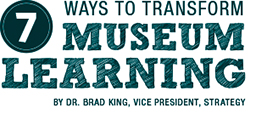1. REVISIT THE MISSION
A museum’s mission statement is more
than obligatory text relegated to a website’s
“About“ page. Rather, it is the “why” of an
institution, its purpose and reason for being,
presented in such a way to inspire support.
Museums are more outward-looking than
ever, and now their missions often reflect a
desire to provide service to society — and
that service today relates very much to
the museum’s role as an informal learning
institution. Revisiting the mission at the
beginning of any process of change is crucial,
not only to rearticulate what the nature of
that service should be, but also to provide
a firm foundation to anchor a museum as
it goes through a potentially tumultuous
process of transformation.
2. TRANSFORM WAYS OF WORKING
The way a museum works as an organization
is critical to its success as a learning
institution. New ways of working might
mean forging stronger connections between
departments, consulting more with the
public, or looking for beneficial partnerships.
They might also mean that processes are put
in place so that the decisions taken are not
necessarily the preferences of department
heads, in order to allow the best ideas to
come to the fore. Such transformations
require institutional cultural change as well
as procedural change, and both can be
difficult, which underlines the importance of
a shared, clearly understood mission to an even greater extent.
3. SUPPORT LEARNING
One of the ways that museums can serve the
public is to help people navigate and thrive
in a rapidly changing society. Museums fulfill
their visitor-centric, social service missions by
recognizing the skills and attributes they can
encourage and support through exhibitions,
programs, and activities. It can be a matter of
creating cues, prompts, or opportunities for
dialogue, alongside other types of supports.
The point is that museums will help create
the conditions for informal learning and
spark visitor engagement.
|
|
4. ALL STAFF ARE EDUCATORS
Staff and volunteers, directors and docents,
and in general everyone who works in
a museum should consider themselves
educators. Job titles and descriptions may
change along with organizational charts, all
with a view to greater responsiveness and
better support of visitor learning. Training will
likely be needed to ensure that interactions
between staff members and the public are
engaging and visitor-centric.
5. APPROACH SPACE HOLISTICALLY
For learning to be diffused throughout
an institution, there needs to be a shift
away from the classroom mentality.
School is where people go to sit in a
classroom and learn a structured
curriculum. But in museums, learning can
happen in every space.
It may mean planning with proper access and
adjacencies in mind — for example, a learning
lab may need to be adjacent to collection
storage, other kinds of storage, or support
space. The point is that desired learning
outcomes and related audience needs
must be kept in mind when thinking about
optimum space allocations or arrangements.
6. MEASURE WHAT MATTERS
All museums collect data and study their
visitors, but planning for learning may mean
using that data in different ways. Or it may
mean changing the way data is collected
— or collecting new types of information
altogether. Existing data can be examined in
new ways — for example, to control visitor
flow and maximize exposure to learning
supports where required. Thinking about
desired outcomes in advance, and ways
to measure success in achieving those
outcomes, will inspire new uses of data
collection or require new ways of measuring altogether.
7. MAKE CHANGE A WAY OF EVERYDAY OPERATION
Museums can only remain relevant in
their social mission to society if they
remain connected to changes in society.
This means that they must be continually
open to constant internal change, growth
and learning. Institutional learning and
experimentation becomes an ongoing
process; the aim is to always be learning and improving.
|
|


 Museums and cultural institutions are undergoing a process of change and are embracing their roles as learning institutions with a
social mission. But to be maximally effective in this goal, an
institution-wide transformation is often required. Our second edition
of The Manual of Museum Learning includes contributions from 19
professionals in the field and provides a practical guide to assist
museums in becoming fully 21st century learning institutions. The following seven
points sum up the book’s key findings and directions:
Museums and cultural institutions are undergoing a process of change and are embracing their roles as learning institutions with a
social mission. But to be maximally effective in this goal, an
institution-wide transformation is often required. Our second edition
of The Manual of Museum Learning includes contributions from 19
professionals in the field and provides a practical guide to assist
museums in becoming fully 21st century learning institutions. The following seven
points sum up the book’s key findings and directions:

